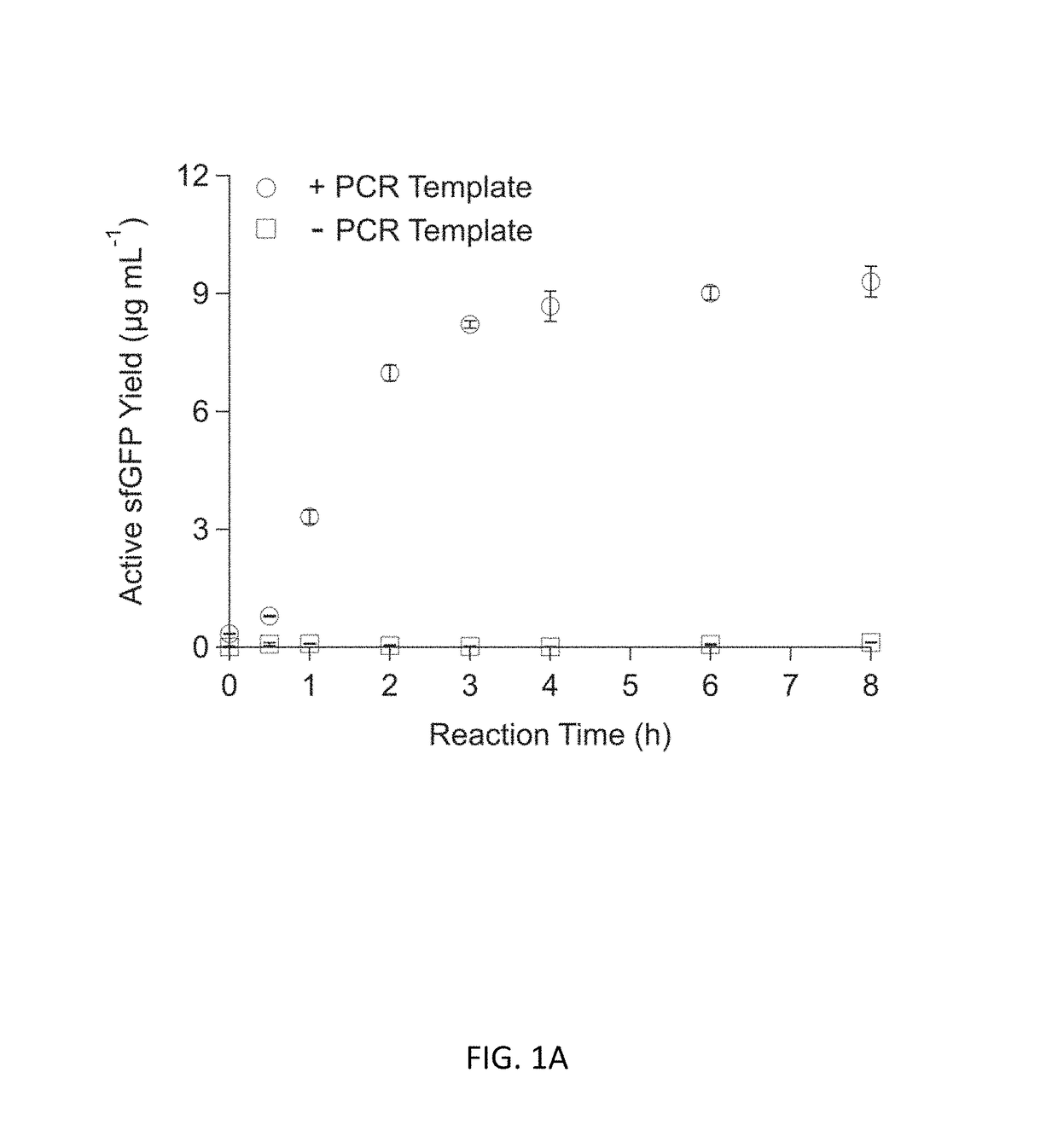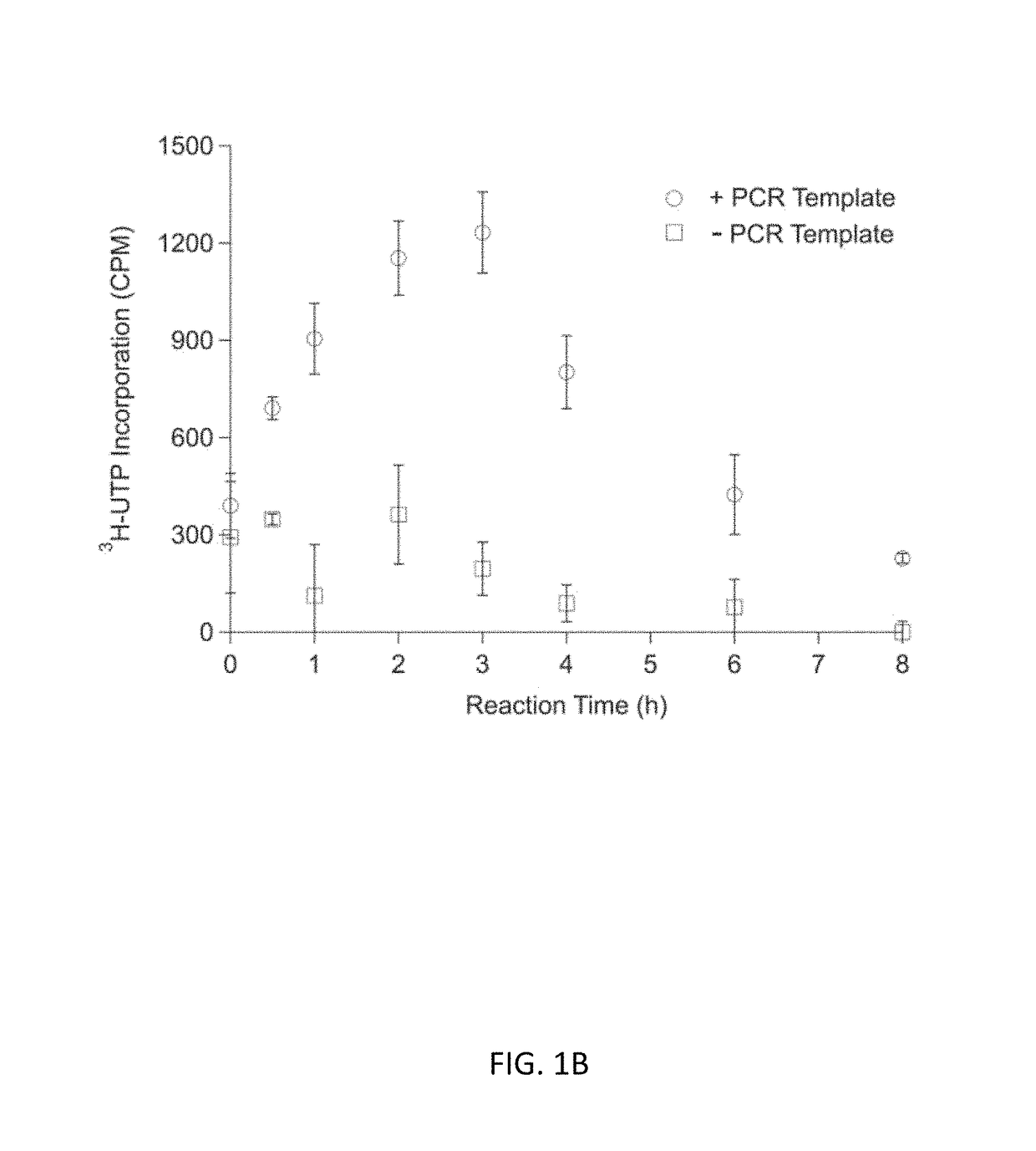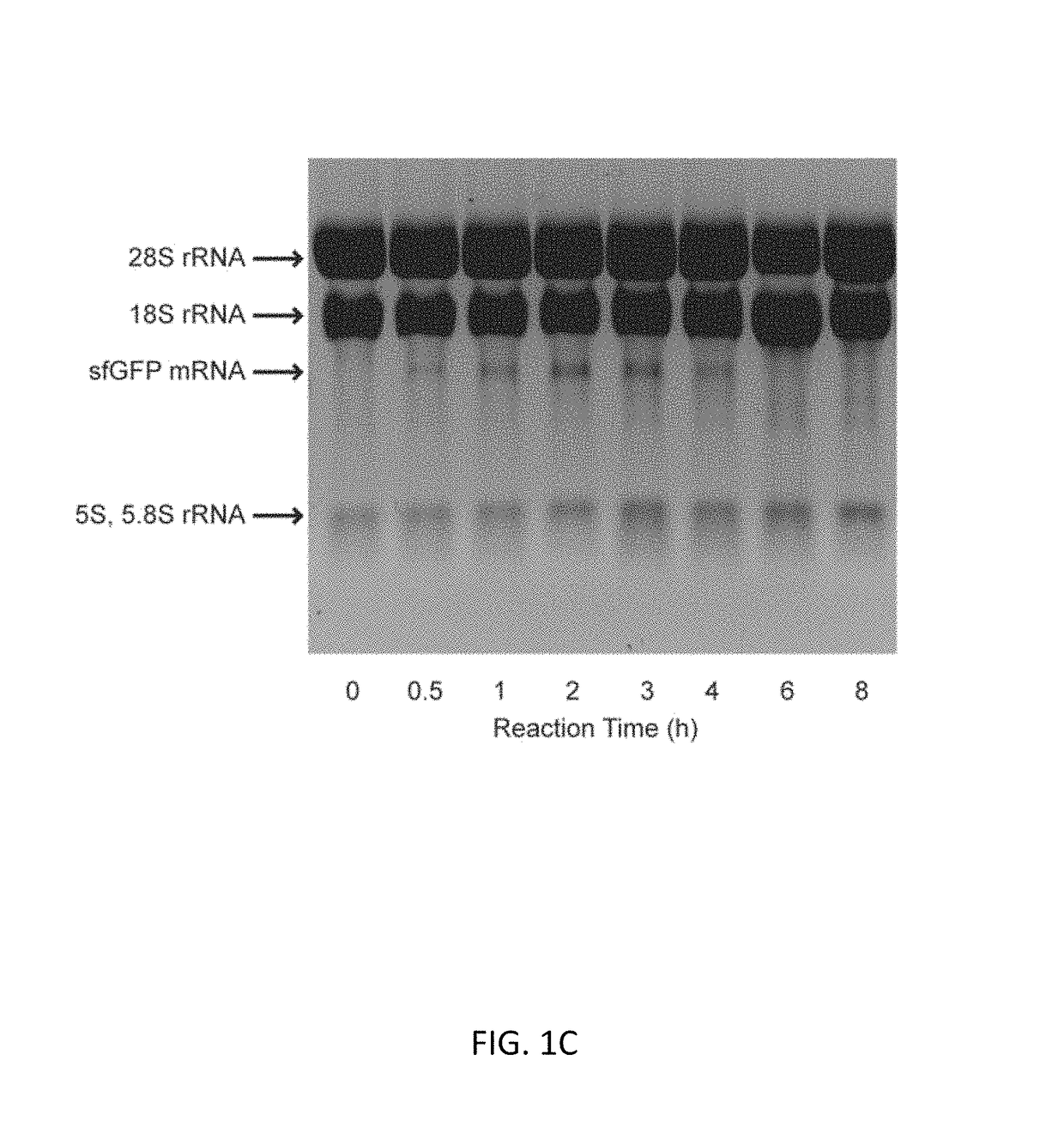Substrate replenishment and byproduct removal improve yeast cell-free protein synthesis
a technology of substrate replenishment and byproduct removal, which is applied in the field of improving yeast cell-free protein synthesis, can solve the problems of low product yield of all eukaryotic cfps systems, laborious extraction preparation procedures, and expensive reagents
- Summary
- Abstract
- Description
- Claims
- Application Information
AI Technical Summary
Benefits of technology
Problems solved by technology
Method used
Image
Examples
example 1
Nucleic Acids and sfGFP DNA Template Preparation
[0087]Linear DNA template encoding for sfGFP was amplified from the pY71sfGFP plasmid (SEQ ID NO:1). A two-stage polymerase chain reaction (PCR) method was adopted to amplify the sfGFP gene as explained below. The plasmid and primer sequences are provided in Table 1.
[0088]
TABLE 1Nucleic acids used for encoding sfGFP amplification productsNucleic Acid[SEQ ID NO:_]Nucleotide Sequence (5′→ 3′)1pY71sfGFPGGATCCTGCAGTTGAGATCCTTTTTTTCTGCGCGTAATCTGCTGCT[SEQ ID NO: 1]TGCAAACAAAAAAACCACCGCTACCAGCGGTGGTTTGTTTGCCGGATCAAGAGCTACCAACTCTTTTTCCGAAGGTAACTGGCTTCAGCAGAGCGCAGATACCAAATACTGTCCTTCTAGTGTAGCCGTAGTTAGGCCACCACTTCAAGAACTCTGTAGCACCGCCTACATACCTCGCTCTGCTAATCCTGTTACCAGTGGCTGCTGCCAGTGGCGATAAGTCGTGTCTTACCGGGTTGGACTCAAGACGATAGTTACCGGATAAGGCGCAGCGGTCGGGCTGAACGGGGGGTTCGTGCACACAGCCCAGCTTGGAGCGAACGACCTACACCGAACTGAGATACCTACAGCGTGAGCATTGAGAAAGCGCCACGCTTCCCGAAGGGAGAAAGGCGGACAGGTATCCGGTAAGCGGCAGGGTCGGAACAGGAGAGCGCACGAGGGAGCTTCCAGGGGGAAACGCCTGGTATCTTTATAGTCCTGTCG...
example 2
Yeast Extract Preparation
[0091]Extracts were prepared by the same method developed by Hodgman & Jewett (2013) with fermentation for cellular growth, high-pressure homogenization for cell lysis, and dialysis for buffer exchange. S. cerevisiae strain MBS was used as the source strain for extract preparation (Iizuka, N., Najita, L., Franzusoff, A., Sarnow, P., “Cap-dependent and cap-independent translation by internal initiation of mRNAs in cell extracts prepared from Saccharomyces cerevisiae.” Mol. Cell. Biol. 1994, 14:7322-7330).
example 3
Cell-Free Protein Synthesis Reactions
[0092]Experiments with CFPS were done with three different reaction systems: (i) batch reactions; (2) fed-batch reactions; and (3) semi-continuous reactions. Each reaction system is described below.
[0093](1) CFPS Batch Reactions
[0094]CFPS batch reactions were carried out according to the method for combined Tx / Tl reactions in Hodgman and Jewett (2013) with the following working concentrations: 22 mM 4-(2-Hydroxyethyl)piperazine-1-ethanesulfonic acid (HEPES)-KOH pH 7.4, 120 mM potassium glutamate, 4.5 mM magnesium glutamate, 1.5 mM each of adenosine triphosphate (ATP), guanosine triphosphate (GTP), cytidine triphosphate (CTP), and uridine triphosphate (UTP), 0.08 mM each of 20 amino acids, 25 mM creatine phosphate, 1.7 mM dithiothreitol (DTT), 1 mM putrescine, 0.5 mM spermidine, 11% v / v glycerol, 0.27 mg mL−1 creatine phosphokinase (from rabbit muscle; Sigma-Aldrich, St. Louis, Mo.), 0.027 mg mL−1 T7 RNA polymerase (made in house following the pro...
PUM
| Property | Measurement | Unit |
|---|---|---|
| pH | aaaaa | aaaaa |
| reaction time | aaaaa | aaaaa |
| time | aaaaa | aaaaa |
Abstract
Description
Claims
Application Information
 Login to View More
Login to View More - R&D
- Intellectual Property
- Life Sciences
- Materials
- Tech Scout
- Unparalleled Data Quality
- Higher Quality Content
- 60% Fewer Hallucinations
Browse by: Latest US Patents, China's latest patents, Technical Efficacy Thesaurus, Application Domain, Technology Topic, Popular Technical Reports.
© 2025 PatSnap. All rights reserved.Legal|Privacy policy|Modern Slavery Act Transparency Statement|Sitemap|About US| Contact US: help@patsnap.com



